When someone asked me: "Dear, what are you doing?", I would at times break my vow of silence and respond: "I make movies, can't you see?". In fact, I tried to extract the images I had seen, those which I had kept in memory and in scraps of paper, and thus I would create outside of myself, among real walls and visible companions. I would spread everything out in the place where I was, just as those who spouted words about the images. Fruitlessly, I could no longer ignore this double imposture of us all.
It was then that I also started writing. I would arm my pen and the imposture was the same. Nothing disturbed me and everyone else more than seeing my scrawls filling the spaces between the images - all white, all prepared. And the quotes, all made mine, in a sort of symbiotic relationship with that resistance of matter. Do you see? It is now the execution of a plan. All harvested, billed, culled in the house across the street, in scattered images, in other people's fleeing conversations. Now they appear: captive, embedded, prepared for this trap that I usually call editing. Isn't that how filmmakers put it? And furthermore, I also act aiming overlapping and by association. Something concerns me: will this assembly as a whole become an element of communication?
Remember that day we went down the street? I asked for a notebook, a little bit of paint, a large piece of wood. And so we continued speaking of our nests. I carved on the notebook cover: inside and outside the painting while you searched for the ink tears around the house. And the first page of this concertina-shaped voyage would bring about the speech, the writing, scenes and documents, which I kept as layers that both overlap and activate my exercises of drawing, of painting and of building objects without overloading them. You see, I do not mean to say that we will be able to remedy our inevitable gaps - between someone who produces and someone who watches this production (I am ashamed of this division, but let us continue so as to avoid external confusion) - but I really want to articulate these instances together, so different from each other, and paste them elsewhere. In the most critical moments, you had proposed that I cut off the thread of this absurd narrative and also avoid didacticism to prepare together a space of invisible arrows.
I can better explain. I know, I know. This is an image and content research, to be transported to a sort of diagram, which will transform this accumulation into a seamless logic among all elements. Thus, we guarantee the restlessness of a narrative in pieces, but which is proposed as a whole, as a story that does not end, and which is also insufficient in itself. For all things that are there, all things having expressed and exchanged their meaning, can return to the inner silence of self-consciousness. And so they twist and turn in their own desires. Each may follow their preferred arrow, and may disperse themselves in the yellow on the floor and even in spaces between phrases.
Still, I catch myself thinking about what each person will see. I show a part of what I have elaborated, which may still seem insufficient. I think of the blue book, of that flying house, of the teacher sitting on a stone, of the white and dirty feet. This happens because no explanation can satisfy. Just like if we asked ourselves why the storyteller changes paragraph to conclude carelessly. Then comes my relief, because I know that everything needs an occasion such as the one invented here: we flood the room, call those who can come, and invite all who are present to look at the window that is on the wall. I do not call this a conclusion. But an adventure in progress, in which we are very small when compared to that which we want to discuss: the dominant frameworks of neoliberal policies that have nothing to propose, our leap to a paradigm shift, the end of the dominant powers and a minimum instance of power of invention of ourselves, subjects, in search of happiness, free access to the common and sustainability of this common.
The title of the fourth solo exhibit by artist Bruno Kurru refers to a dual movement, such as an arrow pointing in opposite directions: a sense of reference, of that which precedes, but which remains blind; and a sense of continuation and consequence that is pulverized, neither assertively nor definitively.
The constructive logic of the works that make up this exhibition are an attempt to address common and urgent contemporary issues, without proposing a solution for them, but rather in an articulation made by the artist, in other contexts: in the field of art, so that, who knows, we may see them and discuss them from a different perspective. Together in a non-consensual coexistence, are: Glauber Rocha, Tarkovsky, drawings, quotes from poems by Décio Pignatari, baffling images from the internet, affective records of Bruno Kurru, landscape portrayals. These collages point to the yearning for a non-consensual space, of distinctive voices, where appropriations and translations are processed. And it is from these thoughts that this writing exercise occurred.
Without being quoted, but as pairs called to a conversation, as freed titles from the intrusive writing conventions, the following are present here: Jean-Paul Sartre (The Words, autobiography published in 1964); Michel Foucault (The Discourse of Language, 1970); Michael Hardt and Antonio Negri (Declaration - this is not a manifesto, 2014).
Galciani Neves

